Adequate and Inadequate Care for Elderly Patients: Reflection on Mr. Taylor's Experience
VerifiedAdded on 2023/06/03
|8
|1702
|324
AI Summary
This essay reflects on the adequate and inadequate care provided to a 75-year-old patient, Mr. Taylor, and includes relevant theories and action plans in compliance with the National Safety and Quality Health Service Standards.
Contribute Materials
Your contribution can guide someone’s learning journey. Share your
documents today.
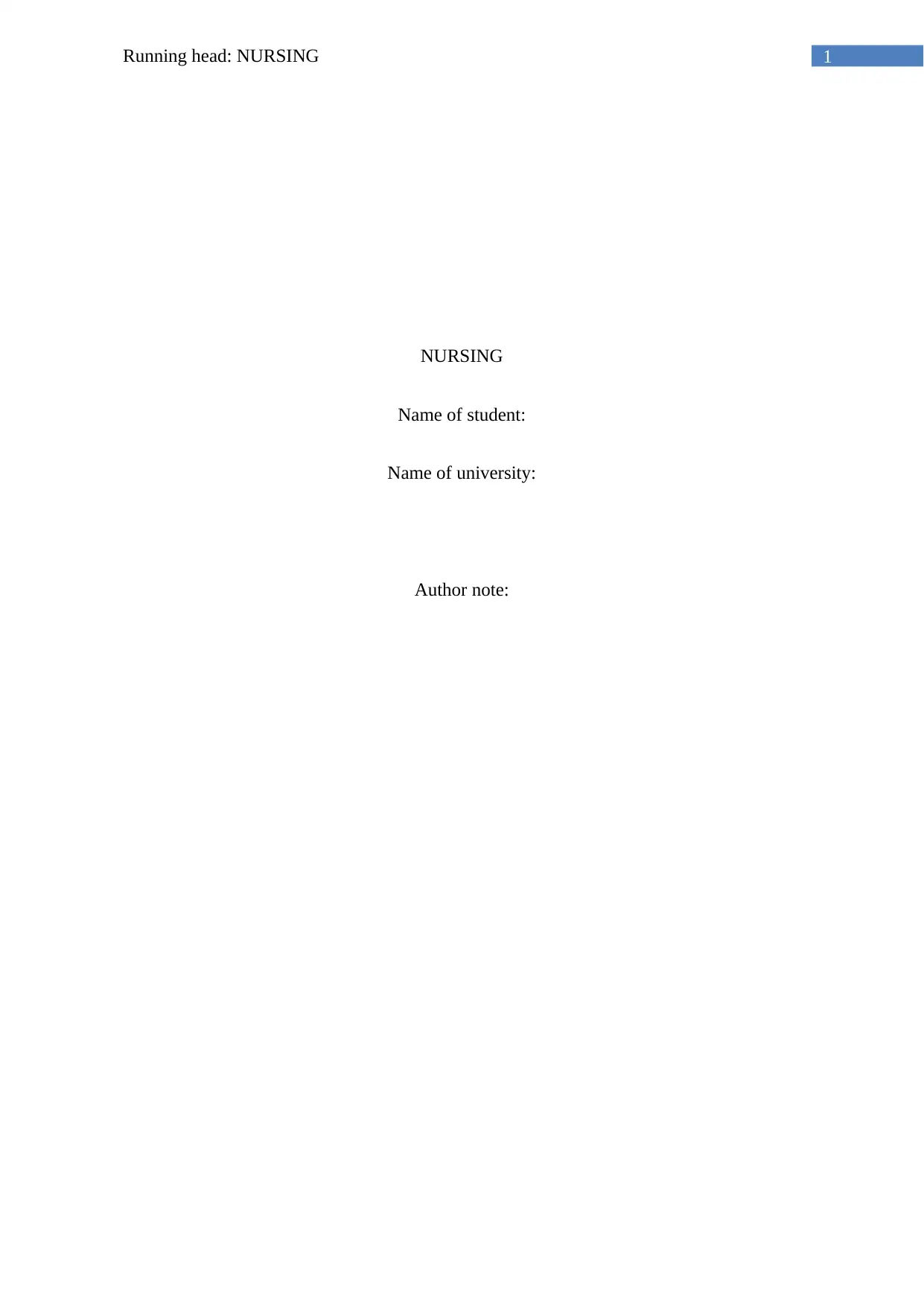
1Running head: NURSING
NURSING
Name of student:
Name of university:
Author note:
NURSING
Name of student:
Name of university:
Author note:
Secure Best Marks with AI Grader
Need help grading? Try our AI Grader for instant feedback on your assignments.
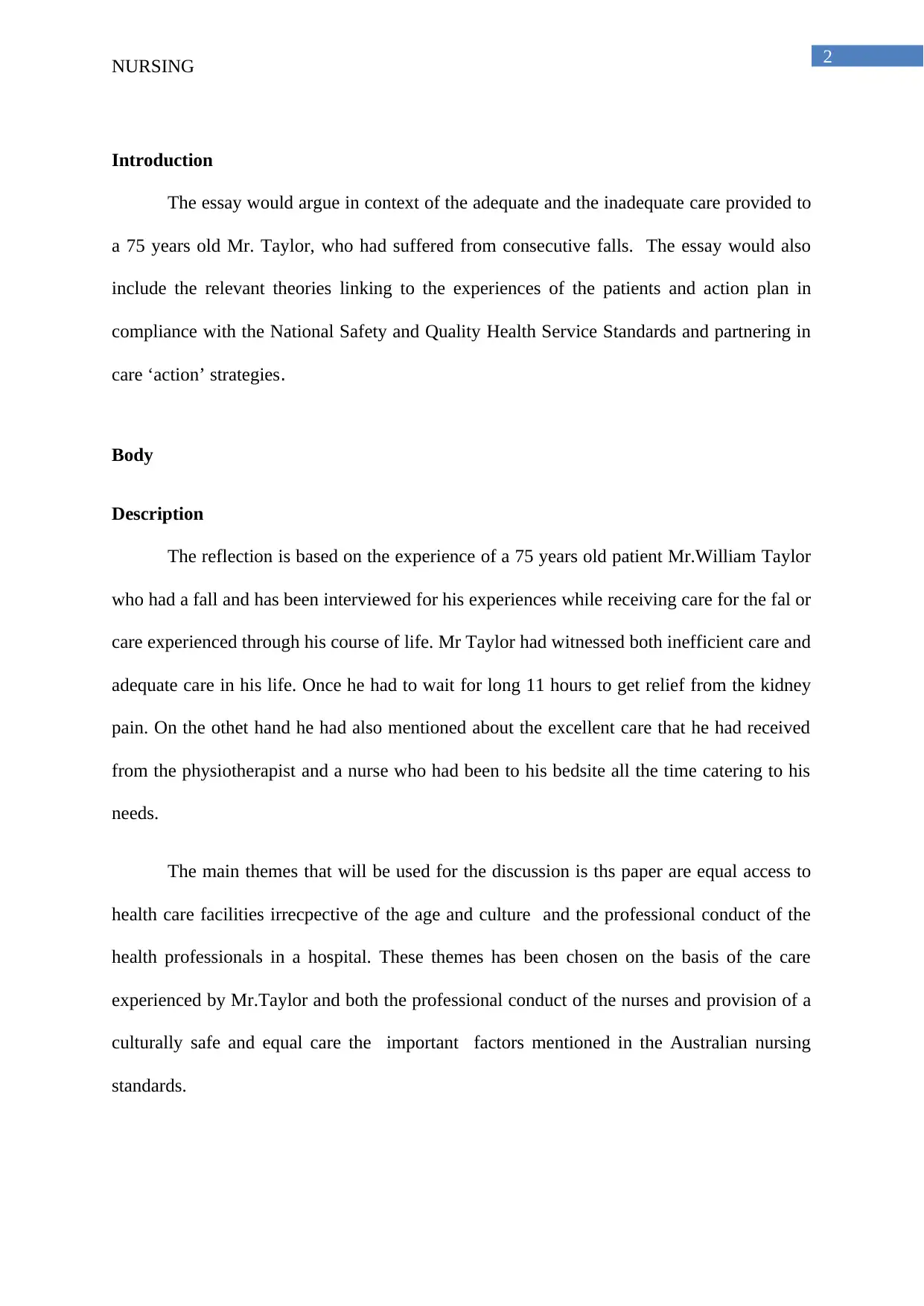
2
NURSING
Introduction
The essay would argue in context of the adequate and the inadequate care provided to
a 75 years old Mr. Taylor, who had suffered from consecutive falls. The essay would also
include the relevant theories linking to the experiences of the patients and action plan in
compliance with the National Safety and Quality Health Service Standards and partnering in
care ‘action’ strategies.
Body
Description
The reflection is based on the experience of a 75 years old patient Mr.William Taylor
who had a fall and has been interviewed for his experiences while receiving care for the fal or
care experienced through his course of life. Mr Taylor had witnessed both inefficient care and
adequate care in his life. Once he had to wait for long 11 hours to get relief from the kidney
pain. On the othet hand he had also mentioned about the excellent care that he had received
from the physiotherapist and a nurse who had been to his bedsite all the time catering to his
needs.
The main themes that will be used for the discussion is ths paper are equal access to
health care facilities irrecpective of the age and culture and the professional conduct of the
health professionals in a hospital. These themes has been chosen on the basis of the care
experienced by Mr.Taylor and both the professional conduct of the nurses and provision of a
culturally safe and equal care the important factors mentioned in the Australian nursing
standards.
NURSING
Introduction
The essay would argue in context of the adequate and the inadequate care provided to
a 75 years old Mr. Taylor, who had suffered from consecutive falls. The essay would also
include the relevant theories linking to the experiences of the patients and action plan in
compliance with the National Safety and Quality Health Service Standards and partnering in
care ‘action’ strategies.
Body
Description
The reflection is based on the experience of a 75 years old patient Mr.William Taylor
who had a fall and has been interviewed for his experiences while receiving care for the fal or
care experienced through his course of life. Mr Taylor had witnessed both inefficient care and
adequate care in his life. Once he had to wait for long 11 hours to get relief from the kidney
pain. On the othet hand he had also mentioned about the excellent care that he had received
from the physiotherapist and a nurse who had been to his bedsite all the time catering to his
needs.
The main themes that will be used for the discussion is ths paper are equal access to
health care facilities irrecpective of the age and culture and the professional conduct of the
health professionals in a hospital. These themes has been chosen on the basis of the care
experienced by Mr.Taylor and both the professional conduct of the nurses and provision of a
culturally safe and equal care the important factors mentioned in the Australian nursing
standards.
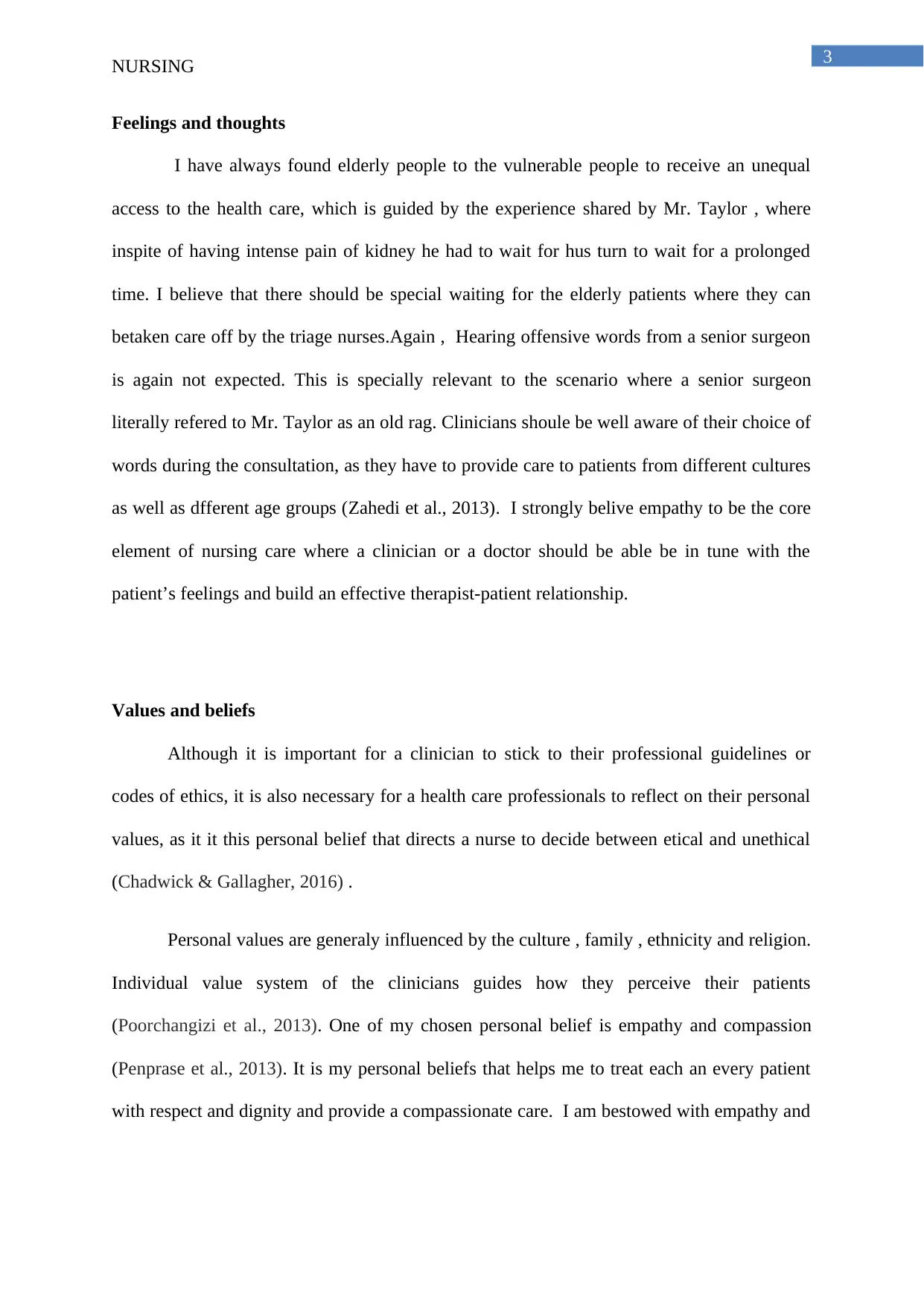
3
NURSING
Feelings and thoughts
I have always found elderly people to the vulnerable people to receive an unequal
access to the health care, which is guided by the experience shared by Mr. Taylor , where
inspite of having intense pain of kidney he had to wait for hus turn to wait for a prolonged
time. I believe that there should be special waiting for the elderly patients where they can
betaken care off by the triage nurses.Again , Hearing offensive words from a senior surgeon
is again not expected. This is specially relevant to the scenario where a senior surgeon
literally refered to Mr. Taylor as an old rag. Clinicians shoule be well aware of their choice of
words during the consultation, as they have to provide care to patients from different cultures
as well as dfferent age groups (Zahedi et al., 2013). I strongly belive empathy to be the core
element of nursing care where a clinician or a doctor should be able be in tune with the
patient’s feelings and build an effective therapist-patient relationship.
Values and beliefs
Although it is important for a clinician to stick to their professional guidelines or
codes of ethics, it is also necessary for a health care professionals to reflect on their personal
values, as it it this personal belief that directs a nurse to decide between etical and unethical
(Chadwick & Gallagher, 2016) .
Personal values are generaly influenced by the culture , family , ethnicity and religion.
Individual value system of the clinicians guides how they perceive their patients
(Poorchangizi et al., 2013). One of my chosen personal belief is empathy and compassion
(Penprase et al., 2013). It is my personal beliefs that helps me to treat each an every patient
with respect and dignity and provide a compassionate care. I am bestowed with empathy and
NURSING
Feelings and thoughts
I have always found elderly people to the vulnerable people to receive an unequal
access to the health care, which is guided by the experience shared by Mr. Taylor , where
inspite of having intense pain of kidney he had to wait for hus turn to wait for a prolonged
time. I believe that there should be special waiting for the elderly patients where they can
betaken care off by the triage nurses.Again , Hearing offensive words from a senior surgeon
is again not expected. This is specially relevant to the scenario where a senior surgeon
literally refered to Mr. Taylor as an old rag. Clinicians shoule be well aware of their choice of
words during the consultation, as they have to provide care to patients from different cultures
as well as dfferent age groups (Zahedi et al., 2013). I strongly belive empathy to be the core
element of nursing care where a clinician or a doctor should be able be in tune with the
patient’s feelings and build an effective therapist-patient relationship.
Values and beliefs
Although it is important for a clinician to stick to their professional guidelines or
codes of ethics, it is also necessary for a health care professionals to reflect on their personal
values, as it it this personal belief that directs a nurse to decide between etical and unethical
(Chadwick & Gallagher, 2016) .
Personal values are generaly influenced by the culture , family , ethnicity and religion.
Individual value system of the clinicians guides how they perceive their patients
(Poorchangizi et al., 2013). One of my chosen personal belief is empathy and compassion
(Penprase et al., 2013). It is my personal beliefs that helps me to treat each an every patient
with respect and dignity and provide a compassionate care. I am bestowed with empathy and
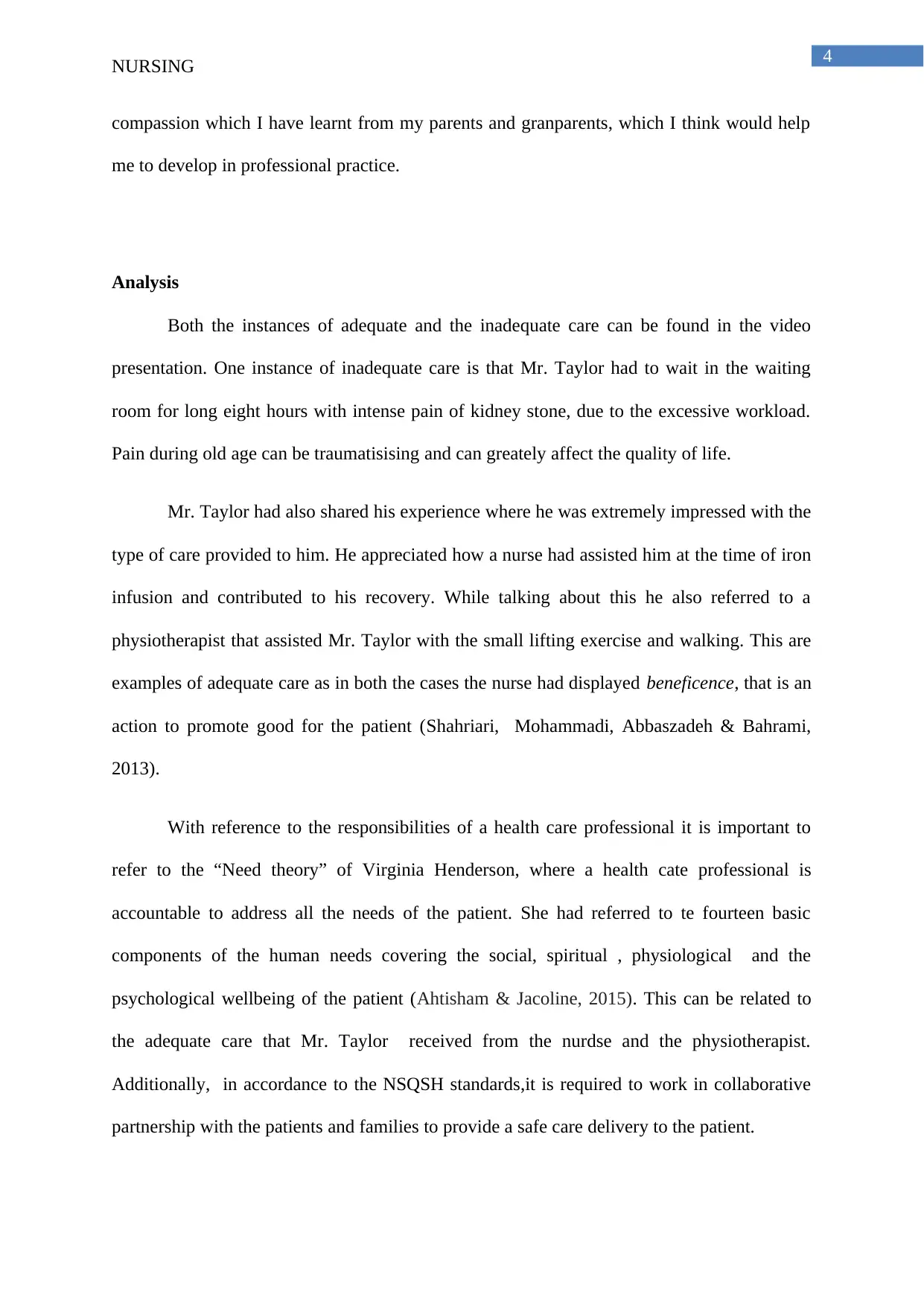
4
NURSING
compassion which I have learnt from my parents and granparents, which I think would help
me to develop in professional practice.
Analysis
Both the instances of adequate and the inadequate care can be found in the video
presentation. One instance of inadequate care is that Mr. Taylor had to wait in the waiting
room for long eight hours with intense pain of kidney stone, due to the excessive workload.
Pain during old age can be traumatisising and can greately affect the quality of life.
Mr. Taylor had also shared his experience where he was extremely impressed with the
type of care provided to him. He appreciated how a nurse had assisted him at the time of iron
infusion and contributed to his recovery. While talking about this he also referred to a
physiotherapist that assisted Mr. Taylor with the small lifting exercise and walking. This are
examples of adequate care as in both the cases the nurse had displayed beneficence, that is an
action to promote good for the patient (Shahriari, Mohammadi, Abbaszadeh & Bahrami,
2013).
With reference to the responsibilities of a health care professional it is important to
refer to the “Need theory” of Virginia Henderson, where a health cate professional is
accountable to address all the needs of the patient. She had referred to te fourteen basic
components of the human needs covering the social, spiritual , physiological and the
psychological wellbeing of the patient (Ahtisham & Jacoline, 2015). This can be related to
the adequate care that Mr. Taylor received from the nurdse and the physiotherapist.
Additionally, in accordance to the NSQSH standards,it is required to work in collaborative
partnership with the patients and families to provide a safe care delivery to the patient.
NURSING
compassion which I have learnt from my parents and granparents, which I think would help
me to develop in professional practice.
Analysis
Both the instances of adequate and the inadequate care can be found in the video
presentation. One instance of inadequate care is that Mr. Taylor had to wait in the waiting
room for long eight hours with intense pain of kidney stone, due to the excessive workload.
Pain during old age can be traumatisising and can greately affect the quality of life.
Mr. Taylor had also shared his experience where he was extremely impressed with the
type of care provided to him. He appreciated how a nurse had assisted him at the time of iron
infusion and contributed to his recovery. While talking about this he also referred to a
physiotherapist that assisted Mr. Taylor with the small lifting exercise and walking. This are
examples of adequate care as in both the cases the nurse had displayed beneficence, that is an
action to promote good for the patient (Shahriari, Mohammadi, Abbaszadeh & Bahrami,
2013).
With reference to the responsibilities of a health care professional it is important to
refer to the “Need theory” of Virginia Henderson, where a health cate professional is
accountable to address all the needs of the patient. She had referred to te fourteen basic
components of the human needs covering the social, spiritual , physiological and the
psychological wellbeing of the patient (Ahtisham & Jacoline, 2015). This can be related to
the adequate care that Mr. Taylor received from the nurdse and the physiotherapist.
Additionally, in accordance to the NSQSH standards,it is required to work in collaborative
partnership with the patients and families to provide a safe care delivery to the patient.
Secure Best Marks with AI Grader
Need help grading? Try our AI Grader for instant feedback on your assignments.
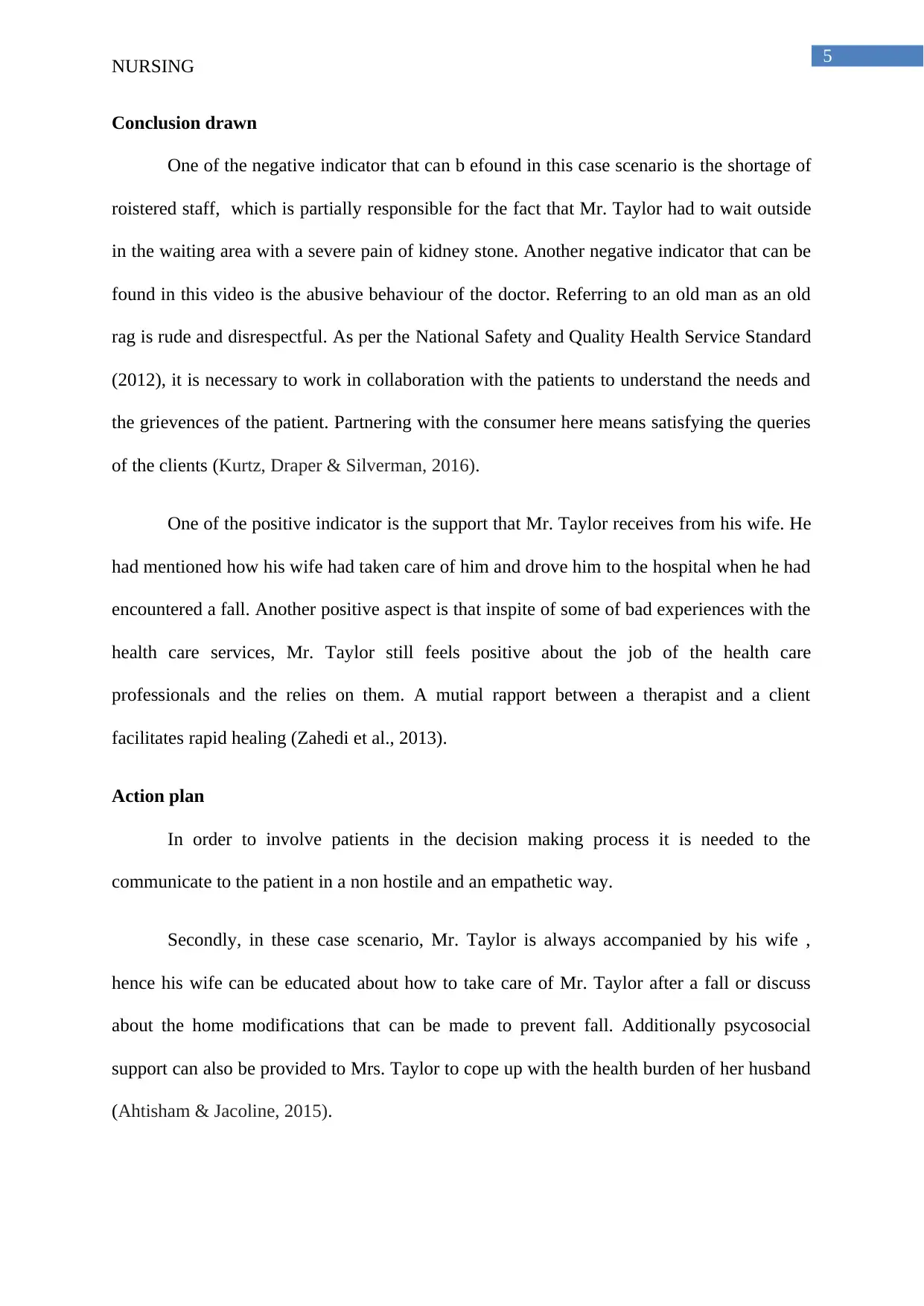
5
NURSING
Conclusion drawn
One of the negative indicator that can b efound in this case scenario is the shortage of
roistered staff, which is partially responsible for the fact that Mr. Taylor had to wait outside
in the waiting area with a severe pain of kidney stone. Another negative indicator that can be
found in this video is the abusive behaviour of the doctor. Referring to an old man as an old
rag is rude and disrespectful. As per the National Safety and Quality Health Service Standard
(2012), it is necessary to work in collaboration with the patients to understand the needs and
the grievences of the patient. Partnering with the consumer here means satisfying the queries
of the clients (Kurtz, Draper & Silverman, 2016).
One of the positive indicator is the support that Mr. Taylor receives from his wife. He
had mentioned how his wife had taken care of him and drove him to the hospital when he had
encountered a fall. Another positive aspect is that inspite of some of bad experiences with the
health care services, Mr. Taylor still feels positive about the job of the health care
professionals and the relies on them. A mutial rapport between a therapist and a client
facilitates rapid healing (Zahedi et al., 2013).
Action plan
In order to involve patients in the decision making process it is needed to the
communicate to the patient in a non hostile and an empathetic way.
Secondly, in these case scenario, Mr. Taylor is always accompanied by his wife ,
hence his wife can be educated about how to take care of Mr. Taylor after a fall or discuss
about the home modifications that can be made to prevent fall. Additionally psycosocial
support can also be provided to Mrs. Taylor to cope up with the health burden of her husband
(Ahtisham & Jacoline, 2015).
NURSING
Conclusion drawn
One of the negative indicator that can b efound in this case scenario is the shortage of
roistered staff, which is partially responsible for the fact that Mr. Taylor had to wait outside
in the waiting area with a severe pain of kidney stone. Another negative indicator that can be
found in this video is the abusive behaviour of the doctor. Referring to an old man as an old
rag is rude and disrespectful. As per the National Safety and Quality Health Service Standard
(2012), it is necessary to work in collaboration with the patients to understand the needs and
the grievences of the patient. Partnering with the consumer here means satisfying the queries
of the clients (Kurtz, Draper & Silverman, 2016).
One of the positive indicator is the support that Mr. Taylor receives from his wife. He
had mentioned how his wife had taken care of him and drove him to the hospital when he had
encountered a fall. Another positive aspect is that inspite of some of bad experiences with the
health care services, Mr. Taylor still feels positive about the job of the health care
professionals and the relies on them. A mutial rapport between a therapist and a client
facilitates rapid healing (Zahedi et al., 2013).
Action plan
In order to involve patients in the decision making process it is needed to the
communicate to the patient in a non hostile and an empathetic way.
Secondly, in these case scenario, Mr. Taylor is always accompanied by his wife ,
hence his wife can be educated about how to take care of Mr. Taylor after a fall or discuss
about the home modifications that can be made to prevent fall. Additionally psycosocial
support can also be provided to Mrs. Taylor to cope up with the health burden of her husband
(Ahtisham & Jacoline, 2015).
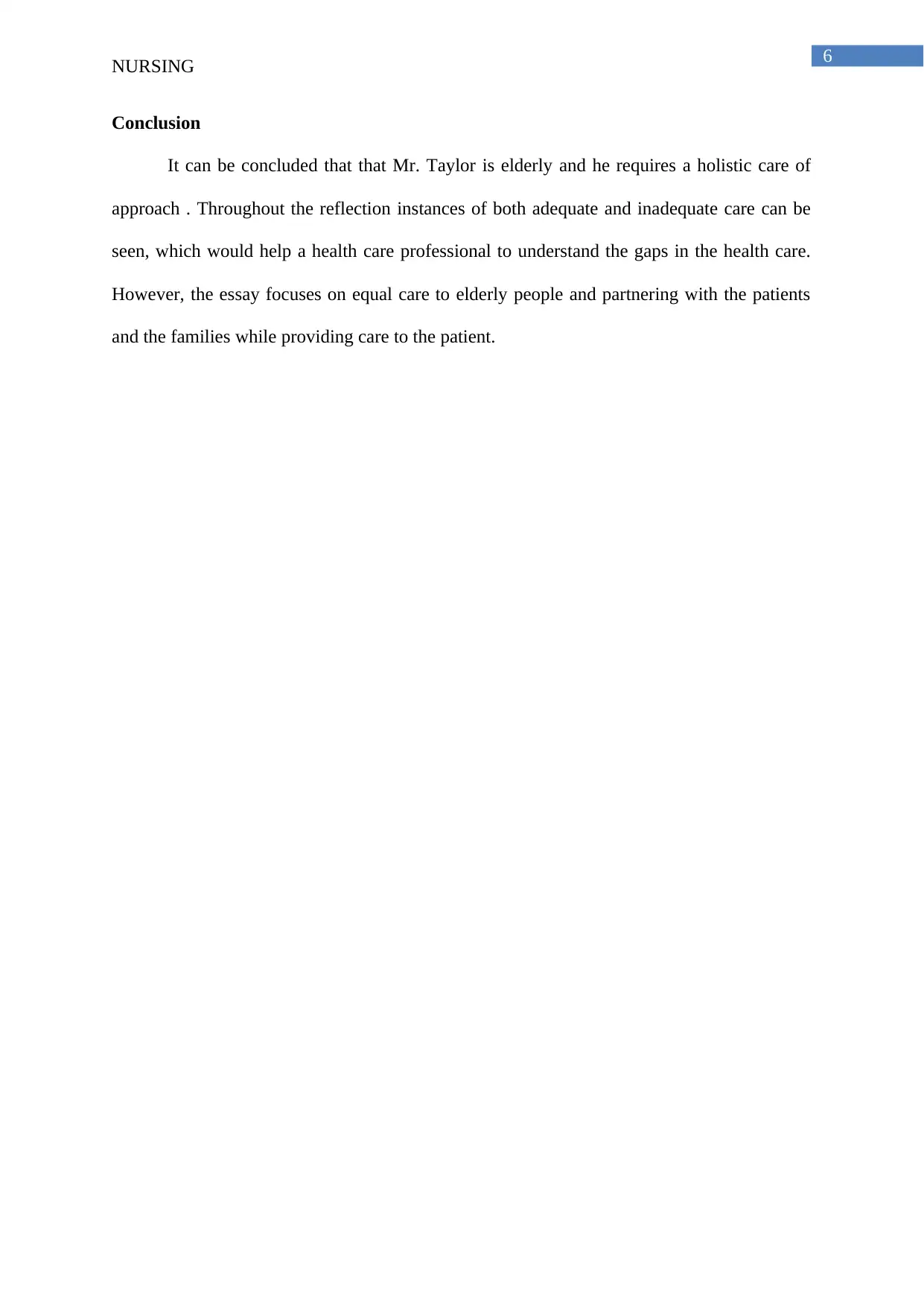
6
NURSING
Conclusion
It can be concluded that that Mr. Taylor is elderly and he requires a holistic care of
approach . Throughout the reflection instances of both adequate and inadequate care can be
seen, which would help a health care professional to understand the gaps in the health care.
However, the essay focuses on equal care to elderly people and partnering with the patients
and the families while providing care to the patient.
NURSING
Conclusion
It can be concluded that that Mr. Taylor is elderly and he requires a holistic care of
approach . Throughout the reflection instances of both adequate and inadequate care can be
seen, which would help a health care professional to understand the gaps in the health care.
However, the essay focuses on equal care to elderly people and partnering with the patients
and the families while providing care to the patient.
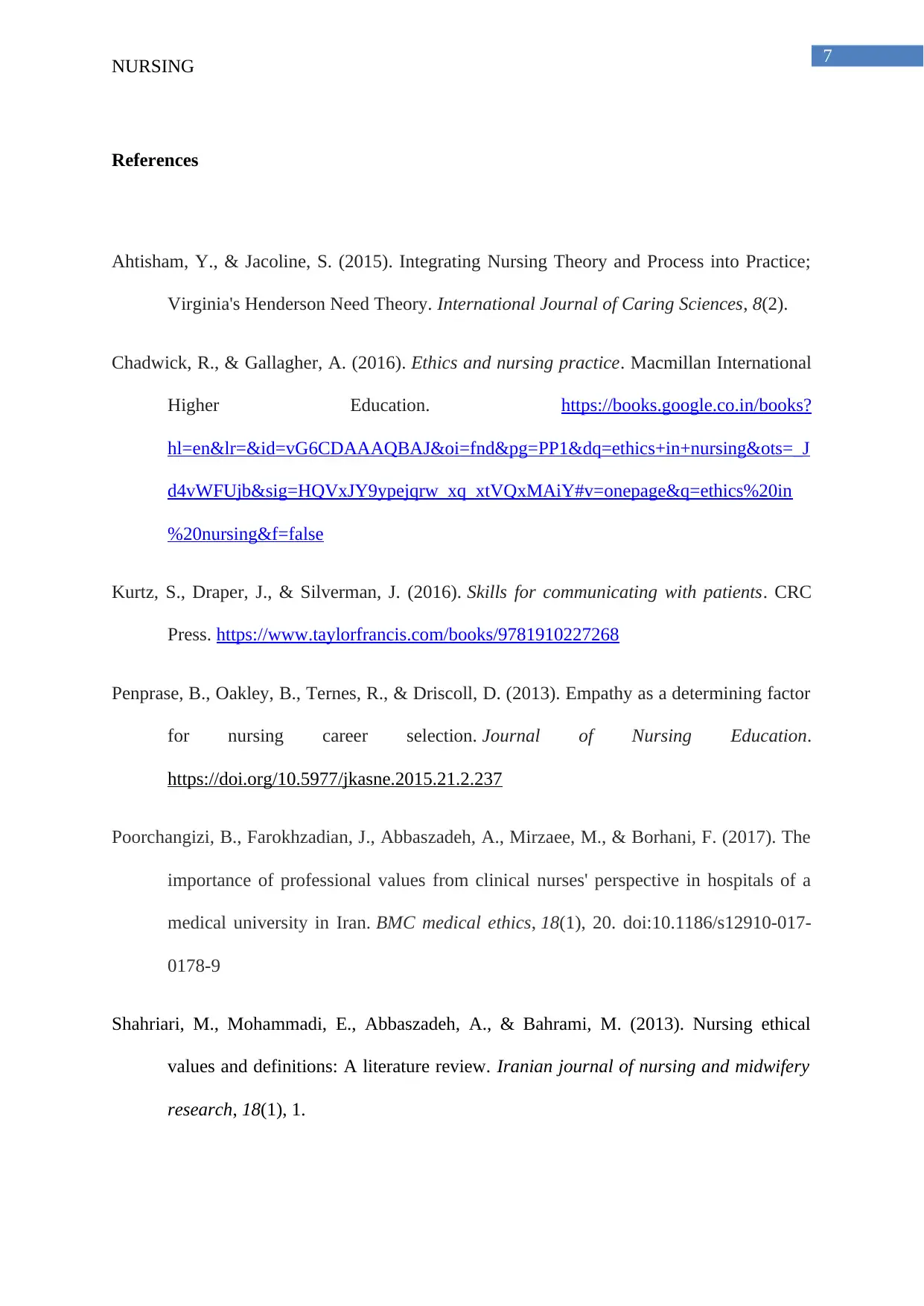
7
NURSING
References
Ahtisham, Y., & Jacoline, S. (2015). Integrating Nursing Theory and Process into Practice;
Virginia's Henderson Need Theory. International Journal of Caring Sciences, 8(2).
Chadwick, R., & Gallagher, A. (2016). Ethics and nursing practice. Macmillan International
Higher Education. https://books.google.co.in/books?
hl=en&lr=&id=vG6CDAAAQBAJ&oi=fnd&pg=PP1&dq=ethics+in+nursing&ots=_J
d4vWFUjb&sig=HQVxJY9ypejqrw_xq_xtVQxMAiY#v=onepage&q=ethics%20in
%20nursing&f=false
Kurtz, S., Draper, J., & Silverman, J. (2016). Skills for communicating with patients. CRC
Press. https://www.taylorfrancis.com/books/9781910227268
Penprase, B., Oakley, B., Ternes, R., & Driscoll, D. (2013). Empathy as a determining factor
for nursing career selection. Journal of Nursing Education.
https://doi.org/10.5977/jkasne.2015.21.2.237
Poorchangizi, B., Farokhzadian, J., Abbaszadeh, A., Mirzaee, M., & Borhani, F. (2017). The
importance of professional values from clinical nurses' perspective in hospitals of a
medical university in Iran. BMC medical ethics, 18(1), 20. doi:10.1186/s12910-017-
0178-9
Shahriari, M., Mohammadi, E., Abbaszadeh, A., & Bahrami, M. (2013). Nursing ethical
values and definitions: A literature review. Iranian journal of nursing and midwifery
research, 18(1), 1.
NURSING
References
Ahtisham, Y., & Jacoline, S. (2015). Integrating Nursing Theory and Process into Practice;
Virginia's Henderson Need Theory. International Journal of Caring Sciences, 8(2).
Chadwick, R., & Gallagher, A. (2016). Ethics and nursing practice. Macmillan International
Higher Education. https://books.google.co.in/books?
hl=en&lr=&id=vG6CDAAAQBAJ&oi=fnd&pg=PP1&dq=ethics+in+nursing&ots=_J
d4vWFUjb&sig=HQVxJY9ypejqrw_xq_xtVQxMAiY#v=onepage&q=ethics%20in
%20nursing&f=false
Kurtz, S., Draper, J., & Silverman, J. (2016). Skills for communicating with patients. CRC
Press. https://www.taylorfrancis.com/books/9781910227268
Penprase, B., Oakley, B., Ternes, R., & Driscoll, D. (2013). Empathy as a determining factor
for nursing career selection. Journal of Nursing Education.
https://doi.org/10.5977/jkasne.2015.21.2.237
Poorchangizi, B., Farokhzadian, J., Abbaszadeh, A., Mirzaee, M., & Borhani, F. (2017). The
importance of professional values from clinical nurses' perspective in hospitals of a
medical university in Iran. BMC medical ethics, 18(1), 20. doi:10.1186/s12910-017-
0178-9
Shahriari, M., Mohammadi, E., Abbaszadeh, A., & Bahrami, M. (2013). Nursing ethical
values and definitions: A literature review. Iranian journal of nursing and midwifery
research, 18(1), 1.
Paraphrase This Document
Need a fresh take? Get an instant paraphrase of this document with our AI Paraphraser
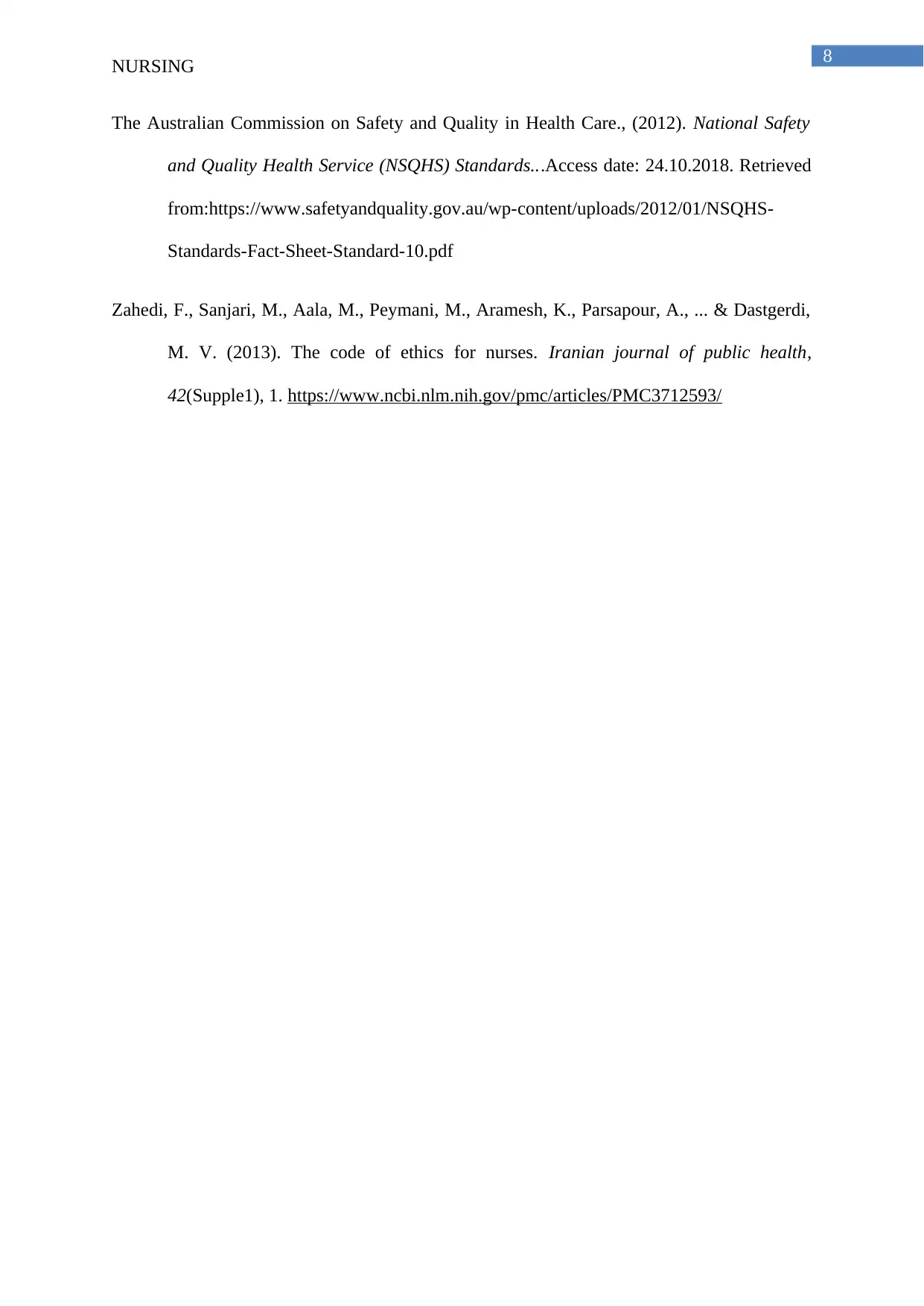
8
NURSING
The Australian Commission on Safety and Quality in Health Care., (2012). National Safety
and Quality Health Service (NSQHS) Standards...Access date: 24.10.2018. Retrieved
from:https://www.safetyandquality.gov.au/wp-content/uploads/2012/01/NSQHS-
Standards-Fact-Sheet-Standard-10.pdf
Zahedi, F., Sanjari, M., Aala, M., Peymani, M., Aramesh, K., Parsapour, A., ... & Dastgerdi,
M. V. (2013). The code of ethics for nurses. Iranian journal of public health,
42(Supple1), 1. https://www.ncbi.nlm.nih.gov/pmc/articles/PMC3712593/
NURSING
The Australian Commission on Safety and Quality in Health Care., (2012). National Safety
and Quality Health Service (NSQHS) Standards...Access date: 24.10.2018. Retrieved
from:https://www.safetyandquality.gov.au/wp-content/uploads/2012/01/NSQHS-
Standards-Fact-Sheet-Standard-10.pdf
Zahedi, F., Sanjari, M., Aala, M., Peymani, M., Aramesh, K., Parsapour, A., ... & Dastgerdi,
M. V. (2013). The code of ethics for nurses. Iranian journal of public health,
42(Supple1), 1. https://www.ncbi.nlm.nih.gov/pmc/articles/PMC3712593/
1 out of 8
Related Documents
Your All-in-One AI-Powered Toolkit for Academic Success.
+13062052269
info@desklib.com
Available 24*7 on WhatsApp / Email
![[object Object]](/_next/static/media/star-bottom.7253800d.svg)
Unlock your academic potential
© 2024 | Zucol Services PVT LTD | All rights reserved.




